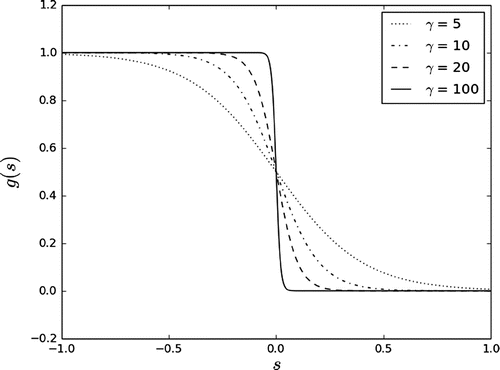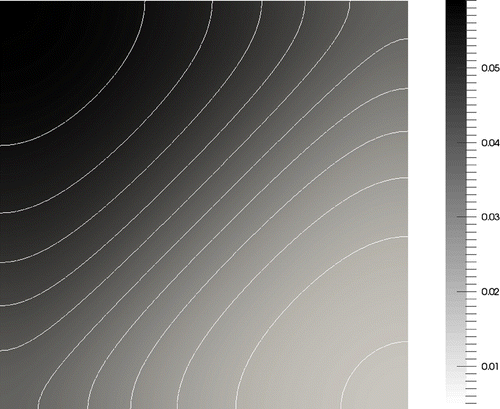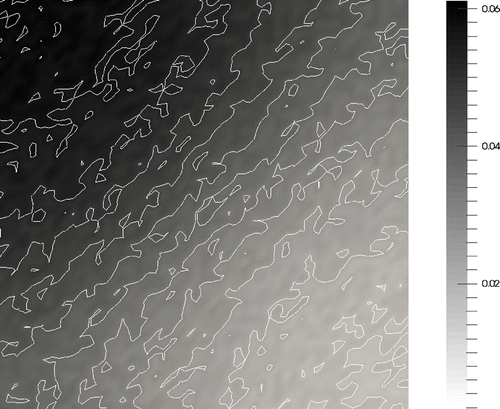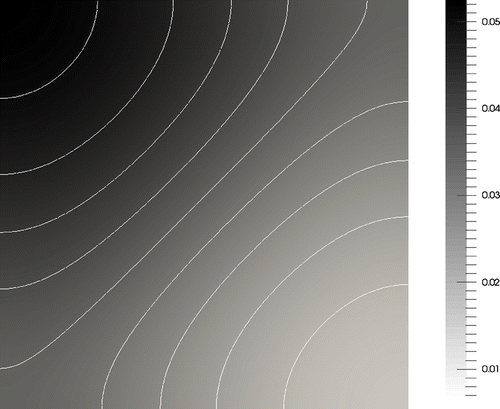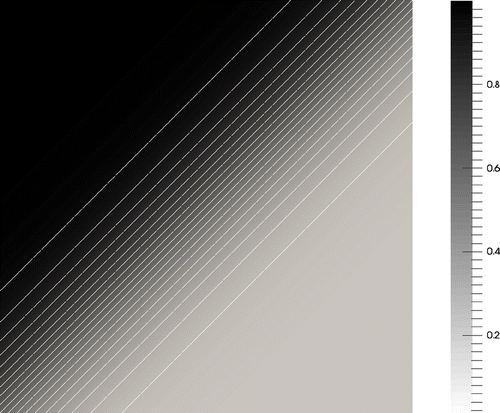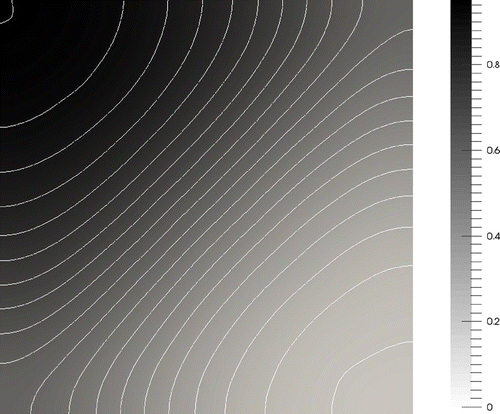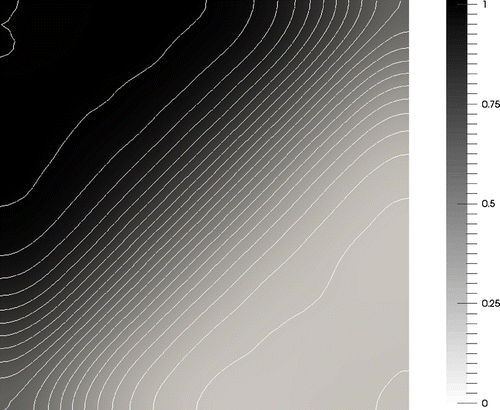 ?Mathematical formulae have been encoded as MathML and are displayed in this HTML version using MathJax in order to improve their display. Uncheck the box to turn MathJax off. This feature requires Javascript. Click on a formula to zoom.
?Mathematical formulae have been encoded as MathML and are displayed in this HTML version using MathJax in order to improve their display. Uncheck the box to turn MathJax off. This feature requires Javascript. Click on a formula to zoom.Abstract
Coefficient inverse problems related to identifying the right-hand side of an equation with use of additional information is of interest among inverse problems for partial differential equations. When considering non-stationary problems, tasks of recovering the dependence of the right-hand side on time and spatial variables can be treated as independent. These tasks relate to a class of linear inverse problems, which sufficiently simplifies their study. This work is devoted to finding the dependence of right-hand side of multidimensional parabolic equation on spatial variables using additional observations of the solution at the final point of time – the final overdetermination. More general problems are associated with some integral observation of the solution in time – the integral overdetermination. The first method of numerical solution of inverse problems is based on iterative solution of boundary value problem for time derivative with non-local acceleration. The second method is based on the known approach with iterative refinement of desired dependence of the right-hand side on spatial variables. Capabilities of proposed methods are illustrated by numerical examples for a two-dimensional problem of identifying the right-hand side of a parabolic equation. The standard finite-element approximation in space is used, whilst the time discretization is based on fully implicit two-level schemes.
1. Introduction
Coefficient inverse problems related to identifying coefficient and/or the right-hand side of an equation with use of some additional information is of interest among inverse problems for partial differential equations.[Citation1,Citation2] When considering non-stationary problems, tasks of recovering the dependence of the right-hand side on time or spatial variables can be usually treated as independent. These tasks relate to a class of linear inverse problems, which sufficiently simplifies their study.[Citation3,Citation4] Only in some cases we have linear inverse problems – identification of the right-hand side of equation, Other coefficient inverse problems are non-linear, that significantly complicate their study.
The problem of identifying the dependence of the right-hand side on spatial variables is one of the most important problems. Additional conditions are often formulated using the solution at the final moment of time – final overdetermination. In a more general case the overdetermination condition is stated as some time integral average – integral overdetermination. The existence and uniqueness of the solution to such an inverse problem and well-posedness of this problem in various functional classes are examined, for example, in the works.[Citation5–Citation9]
In the numerical solution of inverse problem the main focus is on the development of stable computational algorithms that take into account the peculiar properties of inverse problems.[Citation10,Citation11] Inverse problems for partial differential equations can be formulated as optimal control problems.[Citation12,Citation13] Computational algorithms are based on using gradient iterative methods for the corresponding residual functional.[Citation14–Citation16] The implementation of such approaches relates to the solution of initial-boundary problems for the original parabolic equation and its conjugate.
For the required right-hand side of a parabolic equation, which does not depend on time, an inverse problem with final overdetermination can be formulated as a boundary problem for evolution equation of the second order. In this case, we can use standard computational algorithms for the solution of stationary boundary value problems. Such direct computational algorithms based on finite-difference approximation are described in the book [Citation11] (Section 6.4). In the work [Citation17] the identification problem is numerically solved on the basis of transition to an evolutionary problem for the derivative of the solution with respect to time, peculiarity of which is the non-local boundary condition.
In this work, we construct special iterative methods for approximate solution of identification problem of a space-wise dependence of the source in a parabolic equation. They fully take into account inverse problem features, which relate to their evolutionary character. These methods are based on the numerical solution of the standard Cauchy problems at each iteration. The first method is based on the iterative refinement of initial condition for time derivative of the solution. The second method relates to the iterative refinement of the dependence of the right-hand side on the spatial variables. Such approach have been used before.[Citation8,Citation18,Citation19]
The paper is organized as follows. Statements of direct and inverse problems for second-order parabolic equation are given in Section 2. We consider identification problem of the right-hand side of two-dimensional parabolic equation, which does not depend on time. The additional information about the solution of the equation is given at the final moment of time. The finite-element approximation in space is used. The method of approximate solution of inverse problem based on the iterative solution of evolutionary problem for time derivative of the solution with non-local boundary conditions is considered in Section 3. The computational algorithms of iterative identification of the right-hand side of the parabolic equation is discussed in Section 4. In Section 5, we describe the algorithms for solving inverse problems with integral overdetermination. More general inverse problems, which relate to known dependence of the right-hand side on time, are considered in Section 6. Results of computational experiment for model boundary value problem are represented in Section 7. Results of the work are summed up in Section 8.
2. Problem formulation
For simplicity, we restrict ourselves to a 2D problem. Generalization to the 3D case is straightforward. Let and
be a bounded polygon. The direct problem is formulated as follows. We search
,
such that it is the solution of the parabolic equation of second order:
(1)
(1)
with coefficients ,
. The boundary conditions are also specified:
(2)
(2)
where and n is the normal to
. The initial condition is
(3)
(3)
The formulation (Equation1(1)
(1) )–(Equation3
(3)
(3) ) presents the direct problem, where the right-hand side, coefficients of the equation as well as the boundary and initial conditions are specified.
Let us consider the inverse problem, where in Equation (Equation1(1)
(1) ), the right-hand side
is unknown. An additional condition is often formulated as
(4)
(4)
In this case, we speak about the final overdetermination.
We assume that the above inverse problem of finding a pair of from Equations (Equation1
(1)
(1) )–(Equation3
(3)
(3) ) and additional conditions (Equation4
(4)
(4) ) is uniquely solvable. The corresponding conditions for existence and uniqueness of the solution are available in the above-mentioned works in Section 1.
In the Hilbert space , we define the scalar product and norm in the standard way:
To solve numerically the problem (Equation1(1)
(1) )–(Equation3
(3)
(3) ), we employ finite-element approximations in space.[Citation20,Citation21] We define the bilinear form
We have
Define a subspace of finite elements . Let
be triangulation points for the domain
. For example, when using Lagrange finite elements of the first-order (piece-wise linear approximation) we can define pyramid function
, where
For , we have
where .
We define the discrete elliptic operator A as
The operator A acts on a finite-dimensional space and
(5)
(5)
where I is the identity operator in .
For the problem (Equation1(1)
(1) )–(Equation3
(3)
(3) ), we put into the correspondence the operator equation for
:
(6)
(6)
(7)
(7)
where ,
with P denoting
-projection onto
. When considering the inverse problem taking into account (Equation4
(4)
(4) ) assume
(8)
(8)
where .
3. Iterative solution of time derivative problem
For the numerical solution of the inverse problem (Equation6(6)
(6) )–(Equation8
(8)
(8) ) with finding
the simplest approach is to eliminate variable
.[Citation11,Citation17] Differentiating Equation (Equation6
(6)
(6) ) on time, we obtain
(9)
(9)
Further, we consider the boundary value problem (Equation7(7)
(7) )–(Equation9
(9)
(9) ). The correctness of such problem, the computational algorithm and examples of the numerical solution are presented in [Citation11]. The weakness of such approach is caused by the computational complexity of the numerical solution of the boundary problem (Equation7
(7)
(7) )–(Equation9
(9)
(9) ). We practically lose the evolutionary character of original problem and must store data in each time step.
The second approach (see, for example, [Citation17]) is based on considering the time derivative. Let , then Equation (Equation9
(9)
(9) ) can be written as
(10)
(10)
For (Equation10(10)
(10) ) we formulate non-local boundary conditions. From (Equation6
(6)
(6) ) we have
Taking into account (Equation7(7)
(7) ), (Equation8
(8)
(8) ) yields
(11)
(11)
The issues of well-posedness and solvability of non-local problems for parabolic equations are discussed in many papers. We highlight the works [Citation22,Citation23] as the first studies (in our mind) in this direction of investigations
For numerical solution of the problem (Equation10(10)
(10) ), (Equation11
(11)
(11) ) we use the simplest iterative refinement of the initial condition for Equation (Equation10
(10)
(10) ). The iterative process is organized as follows. The new approximation
is found by solving the Cauchy problem:
(12)
(12)
(13)
(13)
with some given . The desired right-hand side of Equation (Equation6
(6)
(6) ) is determined using
, for example, from the equality
(14)
(14)
When studying the convergence of the iterative process (Equation12(12)
(12) ), (Equation13
(13)
(13) ) we consider the problem for error
:
(15)
(15)
(16)
(16)
with given . Multiplying Equation (Equation16
(16)
(16) ) for
in
by
, we obtain
Taking into account (Equation5(5)
(5) ) and
yields
Thus,(17)
(17)
From (Equation15(15)
(15) ) taking into account (Equation17
(17)
(17) ) we have
This gives the desired estimate(18)
(18)
for the convergence of the iterative process (Equation12(12)
(12) )–(Equation14
(14)
(14) ) with linear speed
. For the right-hand side with (Equation14
(14)
(14) ) we have
For computational implementation of proposed algorithm the time approximation deserves special attention. Let us define a uniform for simplicity grid in time
and denote . We consider two-level schemes an so, there is no problem to make a transition to non-uniform temporal grids.
For the numerical solution of the problem (Equation10(10)
(10) ), (Equation11
(11)
(11) ) we used fully implicit two-level scheme [Citation24,Citation25]
(19)
(19)
(20)
(20)
The grid problem (Equation19(19)
(19) ), (Equation20
(20)
(20) ) is solved using the following iterative process:
(21)
(21)
(22)
(22)
and(23)
(23)
The study of the iterative process (Equation21(21)
(21) )–(Equation23
(23)
(23) ) is conducted using the same approach as for the iterative process (Equation12
(12)
(12) )–(Equation14
(14)
(14) ). Let now
, then
(24)
(24)
(25)
(25)
The key moment of our consideration consists in finding an estimate as (Equation17(17)
(17) ).
We multiply Equation (Equation25(25)
(25) ) for
in
by
and obtain
Taking into account (Equation5(5)
(5) ) and
we have ()
Thus,(26)
(26)
Using (Equation24(24)
(24) ), a priori estimate (Equation26
(26)
(26) ) allows us to obtain
Thereby(27)
(27)
which provides the convergence of the iterative process (Equation21(21)
(21) ), (Equation22
(22)
(22) ) (
). The convergence of the right-hand side with (Equation23
(23)
(23) ) is ensured by the estimate
(28)
(28)
This allows us to formulate the following main assertion.
Theorem 3.1:
The iterative process (Equation21(21)
(21) )–(Equation23
(23)
(23) ) for the numerical solution of the problem (Equation6
(6)
(6) )–(Equation8
(8)
(8) ) converges linearly with speed
and the estimates (Equation27
(27)
(27) ), (Equation28
(28)
(28) ) are valid.
The outline of the iterative process (Equation21(21)
(21) )–(Equation23
(23)
(23) ) is as follows:
| (1) | The initial condition is determined using (Equation21 | ||||
| (2) | With this initial condition we solve the grid Cauchy problem (Equation22 | ||||
4. Iterative process for identifying the right-hand side
When studying the correctness of the inverse problem (Equation1(1)
(1) )–(Equation4
(4)
(4) ) the constructive method of iterative refinement of the right-hand side is often used (see, for example, [Citation8,Citation18,Citation19]). We consider the possibility of using this approach for the approximate solution of the problem (Equation6
(6)
(6) )–(Equation8
(8)
(8) ).
In the new iterative step the right-hand side is determined using (Equation6(6)
(6) ) for
, taking into account (Equation8
(8)
(8) ):
(29)
(29)
with some given initial assumption . Then, the Cauchy problem is solved:
(30)
(30)
(31)
(31)
To estimate the convergence we introduce
Then, from (Equation29(29)
(29) )–(Equation31
(31)
(31) ) we obtain
(32)
(32)
(33)
(33)
(34)
(34)
We differentiate Equation (Equation33(33)
(33) ) with respect to time and rewrite it for
in the form
(35)
(35)
The initial condition for (Equation35(35)
(35) ) we obtain from (Equation33
(33)
(33) ) with
, using (Equation34
(34)
(34) ):
(36)
(36)
Similar to (Equation17(17)
(17) ) we have the estimate
(37)
(37)
for the solution of the problem (Equation35(35)
(35) ), (Equation36
(36)
(36) ). In view of (Equation37
(37)
(37) ) from (Equation32
(32)
(32) ) we have the estimate
for the convergence of desired right-hand side.
The time discretization is again formulated based on implicit approximation. Formally, we define the solution of the problem (Equation33(33)
(33) ), (Equation34
(34)
(34) ) on expanded grid:
From (Equation6(6)
(6) )–(Equation8
(8)
(8) ) we come to the problem
(38)
(38)
(39)
(39)
(40)
(40)
For the numerical solution of the problem (Equation38(38)
(38) )–(Equation40
(40)
(40) ) the grid analogue of the iterative process (Equation29
(29)
(29) )–(Equation31
(31)
(31) ) is applied. Now, we compare the relationship
(41)
(41)
with (Equation29(29)
(29) ). To approximate Equation (Equation30
(30)
(30) ) the implicit difference scheme is used
(42)
(42)
under condition (see (Equation31(31)
(31) ))
(43)
(43)
Theorem 4.1:
The iterative process (Equation41(41)
(41) )–(Equation43
(43)
(43) ) for the numerical solution of the problem (Equation38
(38)
(38) )–(Equation40
(40)
(40) ) converges linearly with speed
and the estimate(44)
(44)
is valid.
We define
From (Equation41(41)
(41) )–(Equation43
(43)
(43) ) we obtain
(45)
(45)
(46)
(46)
(47)
(47)
Let’s assume
From (Equation46(46)
(46) ) we get
(48)
(48)
From Equation (Equation46(46)
(46) ) when
using the condition (Equation47
(47)
(47) ) we have
(49)
(49)
Similar to (Equation26(26)
(26) ) for the solution of the problem (Equation48
(48)
(48) ), (Equation49
(49)
(49) ) we prove the a priori estimate
(50)
(50)
From (Equation45(45)
(45) ) and (Equation50
(50)
(50) ) taking into account introduced notation yields
Thus, we have established the estimate (Equation44(44)
(44) ).
5. Integral overdetermination
When considering inverse problem of identifying the right-hand side of parabolic equation, the integral overdetermination is often used instead of the final overdetermination. In this case, in place of Equation (Equation4(4)
(4) ) the following condition is involved
(51)
(51)
where is a given function and
For the numerical solution of the inverse problem (Equation1(1)
(1) )–(Equation3
(3)
(3) ), (Equation51
(51)
(51) ) the iterative process considered above can be used. Here, we note capabilities of iterative refinement of the desired right-hand side.[Citation8,Citation18]
After finite-element approximation in space we come to Equation (Equation6(6)
(6) ), which is supplemented with the initial condition (Equation7
(7)
(7) ). Taking into account (Equation51
(51)
(51) ), we have
(52)
(52)
instead of (Equation8(8)
(8) ). Integrating Equation (Equation6
(6)
(6) ) with weight
over t from 0 to T and taking into account (Equation52
(52)
(52) ), we obtain
(53)
(53)
The iterative refinement of the right-hand side is based on the relation (Equation53(53)
(53) ) (see (Equation29
(29)
(29) )):
(54)
(54)
With new approximation for the right-hand side the Cauchy problem (Equation30(30)
(30) ), (Equation51
(51)
(51) ) is solved. The study of the convergence of the iterative process is performed similarly to the study of the convergence of the process (Equation29
(29)
(29) ), (Equation51
(51)
(51) ).
In view of early introduced notation we have(55)
(55)
and for we have the problem (Equation33
(33)
(33) ), (Equation34
(34)
(34) ). For
we have the problem (Equation35
(35)
(35) ), (Equation36
(36)
(36) ) and the estimate (Equation37
(37)
(37) ) exists. Taking into account this from (Equation5
(5)
(5) ) we obtain
Thus,(56)
(56)
where
For usual assumptions about continuity of the weight function we have
. In the limit case
, where
is the
-function, from (Equation52
(52)
(52) ) we obtain the condition of final overdetermination (Equation8
(8)
(8) ). Other limit case, when
, is not interesting, since two condition at
are set and, as expected, the iterative process does not converge (
).
Theorem 5.1:
The iterative process (Equation30(30)
(30) ), (Equation31
(31)
(31) ), (Equation55
(55)
(55) ) for the numerical solution of the problem (Equation6
(6)
(6) ), (Equation7
(7)
(7) ), (Equation52
(52)
(52) ) for (Equation5
(5)
(5) ) converges linearly with the speed
, while the estimate (Equation56
(56)
(56) ) holds.
Applying an approach similar to the one in Section 3, the iterative process is studied when implicit time discretization is used.
6. More general problems
We have investigated iterative methods for the numerical solution of the inverse problem (Equation1(1)
(1) )–(Equation4
(4)
(4) ), when the right-hand side in (Equation1
(1)
(1) ) does not depend on time. In more general case, instead of (Equation1
(1)
(1) ), we can consider the following equation:
(57)
(57)
where is some given function. The inverse problem of finding the pair
from (Equation2
(2)
(2) )–(Equation4
(4)
(4) ), (Equation57
(57)
(57) ) is stated. We assume that
(58)
(58)
After approximation in space we arrive at the equation(59)
(59)
for , which is supplemented by (Equation7
(7)
(7) ), (Equation8
(8)
(8) ). Taking into account condition (Equation8
(8)
(8) ) and normalization
Equation (Equation59
(59)
(59) ) for
gives
(60)
(60)
Iterative refinement of the right-hand side is performed using (Equation60(60)
(60) ) and has the form (Equation29
(29)
(29) ). When right-hand side is known at the new iteration we solve equation
(61)
(61)
with the initial condition (Equation31(31)
(31) ). For errors
and
we obtain the relation (Equation29
(29)
(29) ), and equation
(62)
(62)
with a uniform initial condition (Equation34(34)
(34) ).
As before, when considering the convergence of the iterative process (Equation29(29)
(29) )–(Equation31
(31)
(31) ), we study the problem for
. From (Equation62
(62)
(62) ) we have
(63)
(63)
From Equation (Equation62(62)
(62) ) for
taking into account (Equation34
(34)
(34) ) the initial condition for Equation (Equation63
(63)
(63) ) is obtained:
(64)
(64)
We multiply Equation (Equation63(63)
(63) ) by
on
, which leads to
Taking into account that the derivative of the function is non-negative and inequality
we obtain
This implies
Integration by t from 0 to T yields
Given the initial condition (Equation64(64)
(64) ) and
we have(65)
(65)
where(66)
(66)
From (Equation29(29)
(29) ) and (Equation65
(65)
(65) ) we obtain the estimate (Equation65
(65)
(65) ), where
is determined according to (Equation66
(66)
(66) ). The result of consideration is the following statement.
Theorem 6.1:
The iterative process (Equation29(29)
(29) ), (Equation30
(30)
(30) ), (Equation61
(61)
(61) ) for the numerical solution of the problem (Equation7
(7)
(7) ), (Equation8
(8)
(8) ), (Equation59
(59)
(59) ) for (Equation5
(5)
(5) ) converges linearly at a rate of
, which is determined according to (Equation66
(66)
(66) ), while the estimate (Equation65
(65)
(65) ) holds.
7. Numerical experiments
We illustrate the performance of iterative solution of inverse problems of identification of the right-hand side of parabolic equations by results of the numerical solution of a test problem. We consider the model problem(67)
(67)
(68)
(68)
(69)
(69)
The forward problem is solved in the unit square
with given right-hand side and the solution at the final time is found
(70)
(70)
After that, the inverse problem is solved when is known, but we need to find
. The right-hand side is taken as
(71)
(71)
For , the right-hand side becomes discontinuous (Figure ).
For the base case we set ,
,
. When solving the forward problem (Equation67
(67)
(67) )–(Equation69
(69)
(69) ) with
given by (Equation71
(71)
(71) ) we use the Crank-Nicolson scheme for time discretization, the time step is
. The uniform mesh with the division into 50 intervals in each direction is used, the Lagrangian finite elements of the second degree are applied. The solution
at the final time is shown in Figure . This is used as input data for the inverse problem. In our analysis we focus on the iterative solution of the problem of identification after the finite element approximation in space. Because of this, we do not discuss the dependence of the accuracy of the approximate solution on the approximation in the space, which is more appropriate in another study. We perform the evaluation of the effect of computational errors on the basis of calculations on different time grids, when using the input data derived from the solution of the forward problem on more detailed time grid and with more accurate approximations in time.
The inverse problem is solved using fully implicit scheme (see (Equation22(22)
(22) ) and (Equation30
(30)
(30) )). The errors of the approximate solution at iteration k are evaluated as follows:
In conducting test predictions, the main issue is to evaluate an actual convergence rate for the iterative processes under the consideration. We need to recognize clearly how quickly the accuracy of an approximate solution is stabilized with increasing the iteration number. The obtained error itself depends on a time step, namely, the smaller time step, the higher accuracy of the approximate solution. Influence of time step of the iterative process (Equation21(21)
(21) )–(Equation23
(23)
(23) ) on accuracy is illustrated in Figure . We see the rapid convergence of the iterative process and the improvement of the accuracy of the approximate solution by reducing the time step. Similar results for the iterative process (Equation41
(41)
(41) )–(Equation43
(43)
(43) ) are shown in Figure . The initial approximation is taken in the form
To increase accuracy of computations, we need to use finer grids in time that result in increasing computational costs. The computational cost trade-off between the time interval and error can be obtained only in practical computations of applied problems.
Figure 3. The iterative process (Equation21(21)
(21) )–(Equation23
(23)
(23) ).
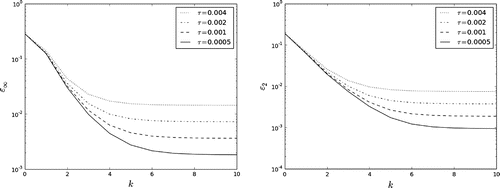
Figure 4. The iterative process (Equation41(41)
(41) )–(Equation43
(43)
(43) ).

The rate of convergence of iterative processes (Equation21(21)
(21) )–(Equation23
(23)
(23) ) and (Equation41
(41)
(41) )–(Equation43
(43)
(43) ) depends essentially on the observation interval, see (Equation28
(28)
(28) ) and (Equation44
(44)
(44) ). The relevant numerical results are presented in Figures and . These computations are carried out for
.
Figure 5. The dependence on T: the iterative process (Equation21(21)
(21) )–(Equation23
(23)
(23) ).
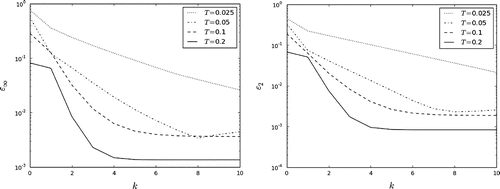
Figure 6. The dependence on T: the iterative process (Equation41(41)
(41) )–(Equation43
(43)
(43) ).
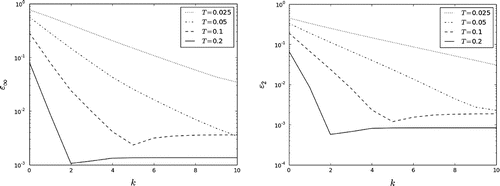
There is a similar dependence of the rate of convergence of the iterative processes (Equation21(21)
(21) )–(Equation23
(23)
(23) ) and (Equation41
(41)
(41) )–(Equation43
(43)
(43) ) on the value of
. For our test problem (Equation67
(67)
(67) )–(Equation69
(69)
(69) ) we have
. The convergence for different values of c is illustrated in Figures and . These computations are carried out for
when
. For some values of problem parameters (e.g. small time intervals T in Figures and or small values of the coefficient c in Figures and ), ten iterations do not guarantee the convergence of iterative processes in our predictions.
Figure 7. The dependence on c: the iterative process (Equation21(21)
(21) )–(Equation23
(23)
(23) ).
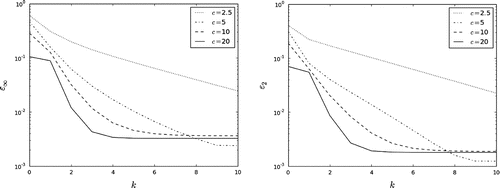
Figure 8. The dependence on c: the iterative process (Equation41(41)
(41) )–(Equation43
(43)
(43) ).

The accuracy of the approximate solution, the rate of convergence of the iterative processes (Equation21(21)
(21) )–(Equation23
(23)
(23) ) and (Equation41
(41)
(41) )–(Equation43
(43)
(43) ) weakly depends on the right-hand side. This is particularly evidenced by the data presented in Tables and .
Table 1. The dependence of on
: the iterative process (Equation21
(21)
(21) )–(Equation23
(23)
(23) ).
Table 2. The dependence of on
: the iterative process (Equation21
(21)
(21) )–(Equation23
(23)
(23) ).
Below are the main points of solving the problem of source identification, where input data (Equation4(4)
(4) ) is given with an error. For the inverse problem (Equation67
(67)
(67) )–(Equation70
(70)
(70) ), we assume that we have noisy data for the solution at the final time-moment. Instead of the exact function
, we have
(72)
(72)
where is a random function uniformly distributed over the interval [0, 1].
The value of specifies the perturbation amplitude. For the basic variant with
, the perturbation in the form (Equation72
(72)
(72) ) is introduced at each node of the computational grid. An example of a noisy solution at the final time-moment that is obtained for the error level corresponding to
is shown in Figure (the exact data are presented in Figure ).
It is necessary to perform a preliminary processing of input data. In our case, this is due to the fact that this overdetermination data should have necessary smoothness. The iterative method (Equation12(12)
(12) ), (Equation13
(13)
(13) ) for solving the non-local problem (Equation10
(10)
(10) ), (Equation11
(11)
(11) ) is associated with the evaluation of
(see (Equation11
(11)
(11) )). When using the iterative method (Equation29
(29)
(29) )–(Equation31
(31)
(31) ), calculations are also based on the evaluation of
(see the right-hand side of (Equation29
(29)
(29) )). Thus, we can expect that the desired approximation of the right-hand side will be smooth if
is smooth.
We solve the inverse problem with
where is obtained by smoothing
. Taking into account the need to work with
, we choose the smoothing functional [Citation26] in the form
(73)
(73)
where is a parameter of smoothing (regularization). The value of
is selected using the discrepancy principle
The minimization problem (Equation73(73)
(73) ) is equivalent to solving the problem
Thus, it is necessary to solve the corresponding boundary value problem for the fourth-order elliptic equation. Computational implementation is based on the use of mixed finite element methods,[Citation27] where the fourth-order equation is written as a system of two second-order equations:
For , in the example under the consideration (see Figure ), the regularization parameter is about
. The smoothed input data is shown in Figure . The exact solution of the inverse problem (the function
with
) is depicted in Figure . The numerical solution of the inverse problem with noisy data is presented in Figure .
Reducing the error amplitude allows to obtain an approximate solution of the inverse problem with higher accuracy. For , the regularization parameter
. The accuracy of the reconstruction of the right-hand side for this case is shown in Figure .
8. Conclusions
| (1) | The problem of identifying the source of a parabolic equation of the second order, which depends only on the space variables, is considered in the work. Additional information about the solution is set at the final time. To approximate in space we use the standard Lagrange finite elements for the triangulation of the computational domain. | ||||
| (2) | The original inverse problem is formulated as a problem with a non-local condition for an evolution equation of the first order. For the approximate solutions of non-classical boundary value problem we propose the iterative process of refinement of the initial condition. We have investigated the rate of convergence of the iterative process with respect to the permanent positive definiteness of operator of the problem and interval time. | ||||
| (3) | We constructed the numerical algorithm based on the well-known approach with iterative refinement of the right-hand side. This algorithm has previously been used to prove the unique solvability of the inverse problem. We have investigated the rate of convergence of the iterative process for an operator differential equation of first order (semi-discrete approximation). Similar results are obtained when using a fully implicit approximations of time (fully discrete approximation). | ||||
| (4) | We have also considered the inverse problem of identification of the right side of the heat equation when the measured data is given in the form of a weighted average over time. The convergence of the iterative process with the refinement of the required right-hand side and the rate of convergence has been given. | ||||
| (5) | We have also studied the more general problem with multiplicative right-hand side, when one multiplier determines the known dependence of the right-hand side on the time, and the second defines the unknown dependence on the spatial variables. The estimates of the rate of convergence of the iterative process with refinement of the right-hand side with respect to parameters of the problem have been obtained. | ||||
| (6) | The capabilities of considered computational algorithms of identification of the right-hand side have been illustrated by the results of a numerical solution of the model inverse problem for the two-dimensional parabolic equation in the unit square. Within the quasi-real computational experiment the additional data for the inverse problem is found using the results of the numerical solution of the forward problem. The calculated data shows a high rate of convergence of the discussed iterative processes of Picard type which do not contain any adjusting parameters. To find the approximate solution of the inverse problem it is sufficient to perform 5–6 iterations, where the standard boundary value problem for a parabolic equation is solved. | ||||
| (7) | Numerical results are presented for the model inverse problem, where data of overdetermination (the solution at the final time) is given with error. This data is smoothed and a smoothing parameter is selected in correspondence with an error level of input data. It was shown that for the problem of identification of the right-hand side, the accuracy of the approximate solution increases with decreasing the error in the input data. | ||||
Acknowledgements
Author would like to thank Prof. Daniel Lesnic and the three reviewers for their insightful comments and suggestions on this manuscript.
Additional information
Funding
Notes
No potential conflict of interest was reported by the author.
References
- Alifanov OM. Inverse heat transfer problems. Berlin: Springer; 2011.
- Lavrent’ev MM, Romanov VG, Shishatskii SP. Ill-posed problems of mathematical physics and analysis. Providence (RI): American Mathematical Society; 1986.
- Isakov V. Inverse problems for partial differential equations. New York (NY): Springer; 2006.
- Prilepko AI, Orlovsky DG, Vasin IA. Methods for solving inverse problems in mathematical physics. New York (NY): Marcel Dekker; 2000.
- Rundell W. Determination of an unknown non-homogeneous term in a linear partial differential equation from overspecified boundary data. Appl. Anal. 1980;10:231–242.
- Prilepko AI, Solov’ev VV. Solvability theorems and the Rothe method in inverse problems for an equation of parabolic type. Differ. Equ. 1987;23:1971–1980.
- Isakov V. Inverse parabolic problems with the final overdetermination. Commun. Pure Appl. Math. 1991;44:185–209.
- Prilepko AI, Kostin AB. On certain inverse problems for parabolic equations with final and integral observation. Sbornik: Math. 1993;75:473–490.
- Kamynin VL. On the inverse problem of determining the right-hand side of a parabolic equation under an integral overdetermination condition. Math. Notes. 2005;77:482–493.
- Vogel CR. Computational Methods for inverse problems. Philadelphia: Society for Industrial and Applied Mathematics; 2002.
- Samarskii AA, Vabishchevich PN. Numerical methods for solving inverse problems of mathematical physics. Berlin: De Gruyter; 2007.
- Lions JL. Optimal control of systems governed by partial differential equations. Berlin: Springer; 1971.
- Maksimov VI. Dynamical inverse problems of distributed systems. Utrecht: VSP; 2002.
- Johansson T, Lesnic D. Determination of a spacewise dependent heat source. J. Comput. Appl. Math. 2007;209:66–80.
- D’haeyer S, Johansson BT, Slodička M. Reconstruction of a spacewise-dependent heat source in a time-dependent heat diffusion process. IMA J. Appl. Math. 2014;79:33–53.
- Hasanov A, Pektaş B. A unified approach to identifying an unknown spacewise dependent source in a variable coefficient parabolic equation from final and integral overdeterminations. Appl. Numer. Math. 2014;78:49–67.
- Xiangtuan X, Yaomei Y, Junxia W. A direct numerical method for solving inverse heat source problems. Vol. 290, Journal of physics: conference series. IOP Publishing; 2011. p. 012017.
- Prilepko AI, Kostin AB. Estimation of the spectral radius of an operator and the solvability of inverse problems for evolution equations. Math. Notes. 1993;53:63–66.
- Kostin AB. The inverse problem of recovering the source in a parabolic equation under a condition of nonlocal observation. Sbornik: Math. 2013;204:1391–1434.
- Brenner SC, Scott LR. The mathematical theory of finite element methods. New York (NY): Springer; 2008.
- Thomée V. Galerkin finite element methods for parabolic problems. Berlin: Springer Verlag; 2006.
- Chabrowski J. On non-local problems for parabolic equations. Nagoya Math. J. 1984;93:109–131.
- Shelukhin VV. On a quadratic functional in a nonlocal boundary value problem for the heat equation. Math. Notes. 1991;49:94–100.
- Samarskii AA. The theory of difference schemes. New York (NY): Marcel Dekker; 2001.
- Samarskii AA, Matus PP, Vabishchevich PN. Difference schemes with operator factors. Dordrecht: Kluwer; 2002.
- Tikhonov AN, Arsenin VY. Solutions of ill-posed problems. Washington: Winston; 1977.
- Brezzi F, Fortin M. Mixed and hybrid finite element methods. Berlin: Springer; 1991.

